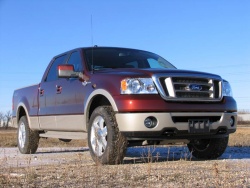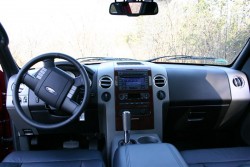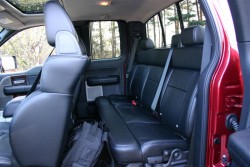 2007 Ford-F150 King Ranch; photo by Haney Louka. Click image to enlarge |
| Manufacturer’s web site Ford Motor Company of Canada Owner Reviews on autoTRADER.ca |
By Chris Chase
The Ford F-150 is one of the most recognizable automotive nameplates around. No surprise when you consider that the F-Series has consistently been one of the best-selling vehicles in Canada for a long time. In the past, strong sales meant that Ford didn’t need to update the F-Series very often, but an increasingly competitive truck segment has forced Ford to keep its meat-and-potatoes model more up to date. The F-Series remained pretty much the same from 1980 to 1997, but underwent a series of significant updates between 1997 and 2009.
The 2004 to 2008 F-150 was available with three engines: a base 4.2L V6, a 4.6L V8, and a 5.4L V8. Transmissions were a five-speed manual that was available only with the V6, and a four-speed automatic that came standard with V8 motors.
Looking at fuel consumption specs, I’d advise skipping the smaller V8. Its rather meagre power advantage over the V6 doesn’t seem to outweigh its extra fuel consumption. Certainly, the 5.4L motor uses more gas than either of the smaller ones, but it is the best engine for heavy towing. The V6 would probably be adequate for occasional hauling and light towing. Granted, a spark plug problem (see below) might make the smaller V8 preferable in order to avoid future maintenance headaches.
Of course, for really heavy duty work, you’ll want to look into one of the more robust F-250/350/450 models. These were available with larger gasoline and diesel V8s and offered much higher payloads and towing capacities.
Half-ton F-150 trucks have a decent reputation as far as long-term durability, but there are a few things to watch for.
 2007 Ford-F150 Lariat. Click image to enlarge |
One common issue in 2004-2006 trucks with the 5.4L three-valve V8 is spark plugs that break off in the cylinder head when it comes time to replace the plugs. This has the potential to turn what should be a simple, routine maintenance item into an expensive problem. Worst case scenario is that the cylinder head(s) have to be removed in order to remove the broken plug(s). Ford issued a Technical Service Bulletin to reduce the chances of this happening. Ford apparently redesigned the 5.4’s heads and spark plugs at the end of November, 2007, so this warning only applies to trucks with that motor built before that date.
The F-150’s four-wheel drive system engages electronically, by way of a dashboard switch and a solenoid under the hood. That solenoid (which is a fancy word for another type of switch) is prone to moisture infiltration. By what I gather from this discussion, a failed solenoid can damage the front hubs and the motor that engages the 4WD gears in the transfer case. Ford redesigned the solenoid to incorporate a little “roof” to keep moisture off of it; you can see some photos of the differences between new and old here.
It’s common (in many rear-wheel drive vehicles, and not just the F-150) for the rear differential to leak where the driveshaft meets it; the culprit is a bad pinion seal.
Front brake rotors that warp easily are another frequent cause of concern, and a hesitation and/or hard shifts from the automatic transmission can often be fixed by reprogramming the transmission control module.
 2007 Ford-F150 Lariat. Click image to enlarge |
An HVAC system that won’t switch between vent modes (or takes a long time to do so) is likely caused by a broken “blend door” assembly. Ford issued a technical service bulletin for this part.
Both Consumer Reports and TrueDelta.com show the F-150 to be a fairly solid truck in general, with few serious common flaws.
Crash safety appears to be good. The National Highway Traffic Safety Administration (NHTSA) gave the 2004 F-150 five stars for driver and front passenger protection in a frontal impact. Also, both two- and four-wheel drive models got four star rollover ratings. Same deal from the Insurance Institute for Highway Safety (IIHS); the F-150 earned that organization’s “good” rating in frontal offset crash testing. Neither organization conducted side impact testing.
According to Canadian Black Book, the F-150 appears to be the least-expensive full-size pickup on the used market, coming in $2,000 to $3,000 less than comparable Chevrolet and Dodge trucks in 1500 configuration. The Toyota Tundra, not surprisingly, is the priciest, and the only full-sizer to get Consumer Reports’ “good bet” recommendation. That said, the F-150 is a solid truck, and a distinct reliability advantage over its domestic competitors, making its lower used values even more attractive.
Be wary of early trucks with the 5.4 L engine, and if this is to be your first truck, make yourself aware of the problems that can—and probably will—happen with a modern 4WD system. Shop carefully, and a used F-150 should prove to be an affordable and durable vehicle.
|
Pricing
Black Book Pricing (avg. retail) June, 2012:
Online resources
There are loads of F-150 sites online, but three of my favourites are F150Forum.com, F150Online.com, Ford-Trucks.com and FordF150.net, all of which have discussion sections dedicated to the 2004–2008 F-150.
Recalls
Transport Canada Recall Number: 2004317; Units affected: 16
2004: Certain vehicles may have a fuel tank with a depression at the seam between top and bottom halves of the tank (not visible from outside the fuel tank). If a depression is large enough, fuel may permeate the fuel tank wall resulting in a fuel odour, illumination of the “Service Engine Soon” indicator light, or a fuel leak. A fuel leak in the presence of an ignition source could result in a fire. Correction: Dealers will replace the fuel tank.
Transport Canada Recall Number: 2004141; Units affected: 20 Transport Canada Recall Number: 2006032; Units affected: 17,390 Transport Canada Recall Number: 2005356; Units affected: 13,581 Transport Canada Recall Number: 2007241; Units affected: 4 Transport Canada Recall Number: 2004167; Units affected: 208 Transport Canada Recall Number: 2005182; Units affected: 5,528 Transport Canada Recall Number: 2007099; Units affected: 4,307 Transport Canada Recall Number: 2007100; Units affected: 52 Transport Canada Recall Number: 2005183; Units affected: 16,601 Crash test results
Used vehicle prices vary depending on factors such as general condition, odometer reading, usage history and options fitted. Always have a used vehicle checked by an experienced auto technician before you buy.For information on recalls, see Transport Canada’s web-site, www.tc.gc.ca, or the U.S. National Highway Transportation Administration (NHTSA)web-site, www.nhtsa.dot.gov. For information on vehicle service bulletins issued by the manufacturer, visit www.nhtsa.dot.gov. For information on consumer complaints about specific models, see www.lemonaidcars.com. |











